Pharmacology for Nursing: Drug Protocol and Critical Discussion
VerifiedAdded on 2021/06/18
|13
|2748
|285
Report
AI Summary
This report provides a comprehensive drug protocol and critical discussion focusing on the administration of atorvastatin for the treatment of high cholesterol levels in a patient with diabetes. The report details the drug's clinical indications, inclusion/exclusion criteria, pharmacodynamics, pharmacokinetics (ADME), drug interactions, dosage, adverse effects, and management of adverse events. The core of the report centers on clinical decision-making in nursing, specifically the assessment, implementation, and evaluation of medication management for a diabetic patient, Mavis. It emphasizes the importance of patient education, including the side effects of metformin, glibenclamide, and atorvastatin, and the significance of diet, exercise, and adherence to medication schedules. The report also addresses cultural requirements, highlighting the need to understand and accommodate the patient's cultural values and beliefs to ensure effective communication and safe medication administration. Overall, the report underscores the nurse's role in ensuring safe and quality medication use through a holistic approach that considers both the pharmacological aspects of the drug and the patient's individual needs and cultural context.
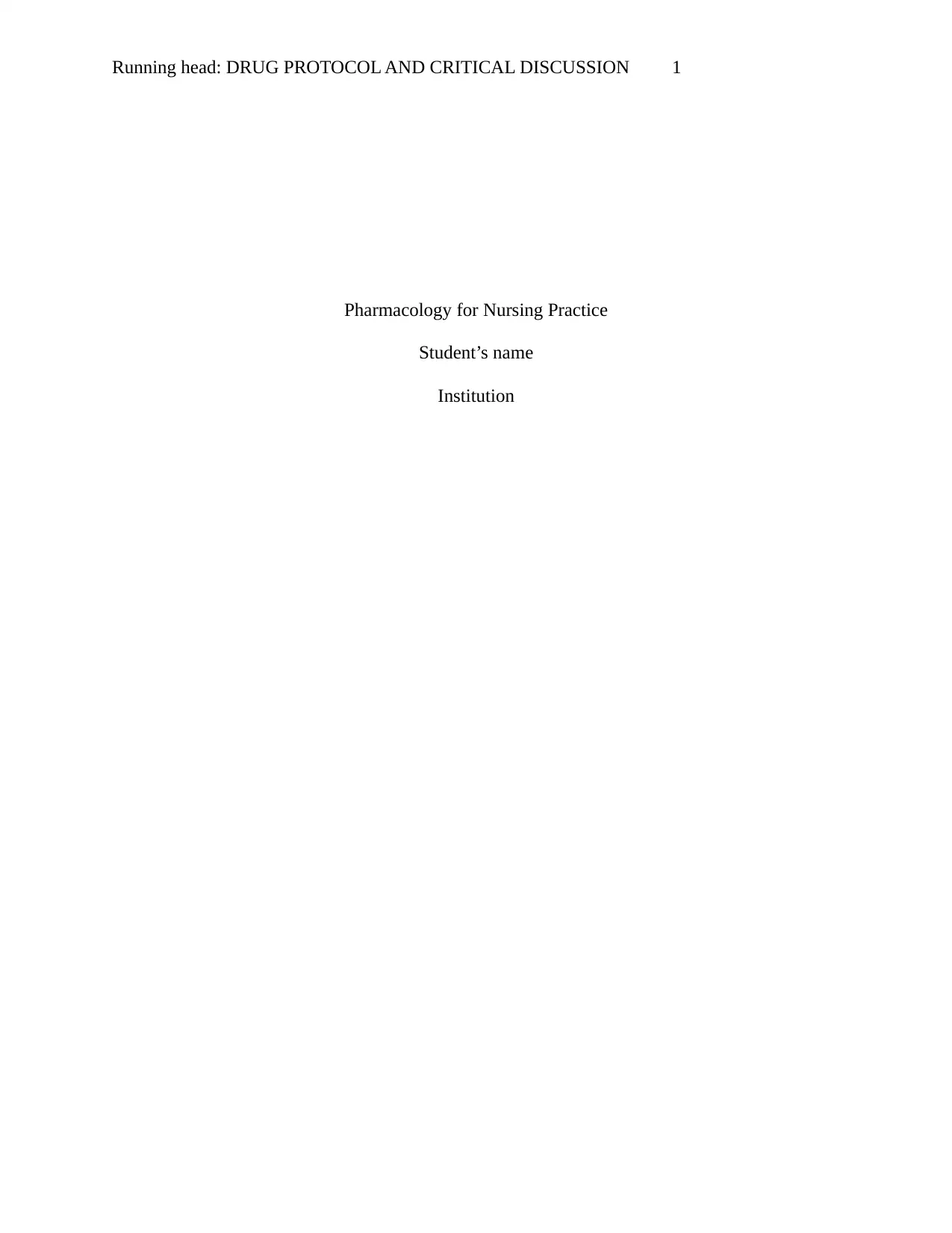
Running head: DRUG PROTOCOL AND CRITICAL DISCUSSION 1
Pharmacology for Nursing Practice
Student’s name
Institution
Pharmacology for Nursing Practice
Student’s name
Institution
Paraphrase This Document
Need a fresh take? Get an instant paraphrase of this document with our AI Paraphraser
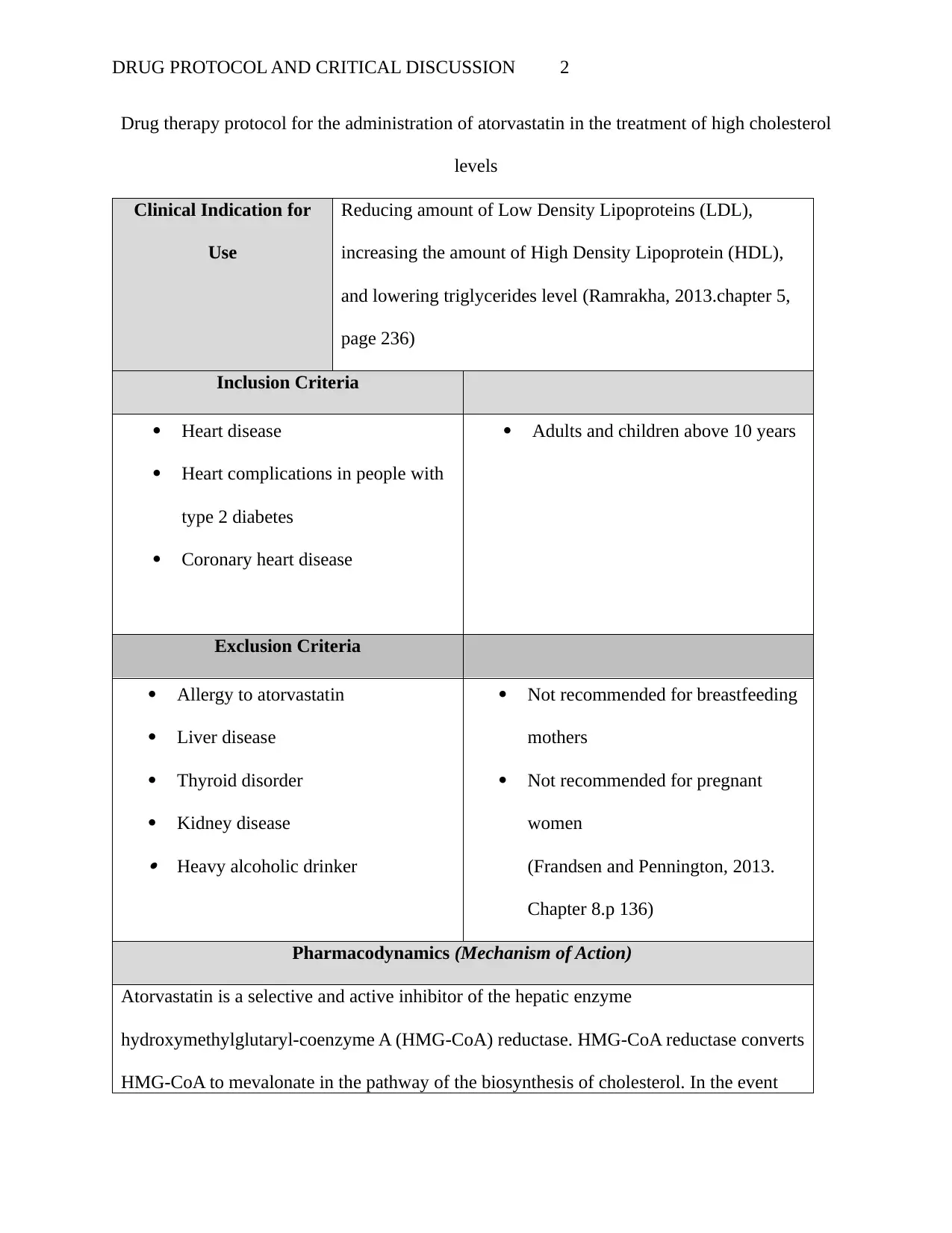
DRUG PROTOCOL AND CRITICAL DISCUSSION 2
Drug therapy protocol for the administration of atorvastatin in the treatment of high cholesterol
levels
Clinical Indication for
Use
Reducing amount of Low Density Lipoproteins (LDL),
increasing the amount of High Density Lipoprotein (HDL),
and lowering triglycerides level (Ramrakha, 2013.chapter 5,
page 236)
Inclusion Criteria
Heart disease
Heart complications in people with
type 2 diabetes
Coronary heart disease
Adults and children above 10 years
Exclusion Criteria
Allergy to atorvastatin
Liver disease
Thyroid disorder
Kidney disease Heavy alcoholic drinker
Not recommended for breastfeeding
mothers
Not recommended for pregnant
women
(Frandsen and Pennington, 2013.
Chapter 8.p 136)
Pharmacodynamics (Mechanism of Action)
Atorvastatin is a selective and active inhibitor of the hepatic enzyme
hydroxymethylglutaryl-coenzyme A (HMG-CoA) reductase. HMG-CoA reductase converts
HMG-CoA to mevalonate in the pathway of the biosynthesis of cholesterol. In the event
Drug therapy protocol for the administration of atorvastatin in the treatment of high cholesterol
levels
Clinical Indication for
Use
Reducing amount of Low Density Lipoproteins (LDL),
increasing the amount of High Density Lipoprotein (HDL),
and lowering triglycerides level (Ramrakha, 2013.chapter 5,
page 236)
Inclusion Criteria
Heart disease
Heart complications in people with
type 2 diabetes
Coronary heart disease
Adults and children above 10 years
Exclusion Criteria
Allergy to atorvastatin
Liver disease
Thyroid disorder
Kidney disease Heavy alcoholic drinker
Not recommended for breastfeeding
mothers
Not recommended for pregnant
women
(Frandsen and Pennington, 2013.
Chapter 8.p 136)
Pharmacodynamics (Mechanism of Action)
Atorvastatin is a selective and active inhibitor of the hepatic enzyme
hydroxymethylglutaryl-coenzyme A (HMG-CoA) reductase. HMG-CoA reductase converts
HMG-CoA to mevalonate in the pathway of the biosynthesis of cholesterol. In the event

DRUG PROTOCOL AND CRITICAL DISCUSSION 3
where HMG-CoA reductase is inhibited by atorvastatin, there is a successive decrease in
the levels of the hepatic cholesterol. Consequently, decrease in the levels of hepatic
cholesterol stimulates the upregulation of hepatic Low-Density Lipoproteins Cholesterol
(LDL-C) receptors thereby leading to an increase in hepatic uptake of LDL-C and reduces
the concentrations of serum LDL-C (Moscou and Snipe, 2012. Chapter 24, p.393)
Pharmacokinetics (ADME)
Administration and absorption
Atorvastatin is rapidly absorbed after oral administration with or without food. The
medication can be taken at any time every day but it is advisable to take it at around the
same time every day. Atorvastatin is absolutely bioavailable at about 14% while the
systemic availability of HMG-CoA inhibitory activity is at about 30%.
Distribution
Maximum concentration of plasma is accomplished in 1-2 hours after administration. The
mean distribution volume is approximately 381litres and it is about 98% protein bound to
the plasma membrane
Metabolism
Atorvastatin is metabolized to its ortho and para hydroxylated derivative and to its several
products of beta oxidation. About 70% of HMG-CoA reductase inhibitory activity has been
accredited to the active metabolites of atorvastatin
Excretion
Atorvastatin is eliminated in bile after extrahepatic or hepatic metabolism. Less than 2% of
the orally administered dose of atorvastatin is recovered in urine (Frandsen and
Pennington, 2013. Chapter 8.p 134).
where HMG-CoA reductase is inhibited by atorvastatin, there is a successive decrease in
the levels of the hepatic cholesterol. Consequently, decrease in the levels of hepatic
cholesterol stimulates the upregulation of hepatic Low-Density Lipoproteins Cholesterol
(LDL-C) receptors thereby leading to an increase in hepatic uptake of LDL-C and reduces
the concentrations of serum LDL-C (Moscou and Snipe, 2012. Chapter 24, p.393)
Pharmacokinetics (ADME)
Administration and absorption
Atorvastatin is rapidly absorbed after oral administration with or without food. The
medication can be taken at any time every day but it is advisable to take it at around the
same time every day. Atorvastatin is absolutely bioavailable at about 14% while the
systemic availability of HMG-CoA inhibitory activity is at about 30%.
Distribution
Maximum concentration of plasma is accomplished in 1-2 hours after administration. The
mean distribution volume is approximately 381litres and it is about 98% protein bound to
the plasma membrane
Metabolism
Atorvastatin is metabolized to its ortho and para hydroxylated derivative and to its several
products of beta oxidation. About 70% of HMG-CoA reductase inhibitory activity has been
accredited to the active metabolites of atorvastatin
Excretion
Atorvastatin is eliminated in bile after extrahepatic or hepatic metabolism. Less than 2% of
the orally administered dose of atorvastatin is recovered in urine (Frandsen and
Pennington, 2013. Chapter 8.p 134).
⊘ This is a preview!⊘
Do you want full access?
Subscribe today to unlock all pages.

Trusted by 1+ million students worldwide

DRUG PROTOCOL AND CRITICAL DISCUSSION 4
Drug Interactions
Antibiotics such as erythromycin- the serum concentration of atorvastatin may be
increased
Antifungal medications such as fluconazole- the risk of severity of adverse effects
is likely to be increased when fluconazole is combined with atorvastatin
Ciprofloxacin- the risk of severity of adverse effects is likely to be increased when
ciprofloxacin is combined with atorvastatin
Ciprofibrate-the severity of myopathy, myoglobulin, and rhabdomyolysis can be increased
when ciprofibrate is combined with atorvastatin (Moscou and Snipe, 2012. Chapter 24,
p.394).
Dose, Route, Duration of Therapy
Adult:
Dose and Route
Initial dose: 10mg or 20mg orally once a day. Initial dose of 40mg to be used in patients
who need LDL-C reduction of more than 45% (Frandsen and Pennington, 2013. Chapter
8.p 134)
Maintenance dose: 10mg to 80mg orally once a day
Duration of therapy
2-4 weeks and evaluation of lipids levels done
Adverse Effects
Side effects
Diarrhoea, heartburn, gas, joint pain (Frandsen and Pennington, 2013. Chapter 8.p 136)
Hypersensitivity
Drug Interactions
Antibiotics such as erythromycin- the serum concentration of atorvastatin may be
increased
Antifungal medications such as fluconazole- the risk of severity of adverse effects
is likely to be increased when fluconazole is combined with atorvastatin
Ciprofloxacin- the risk of severity of adverse effects is likely to be increased when
ciprofloxacin is combined with atorvastatin
Ciprofibrate-the severity of myopathy, myoglobulin, and rhabdomyolysis can be increased
when ciprofibrate is combined with atorvastatin (Moscou and Snipe, 2012. Chapter 24,
p.394).
Dose, Route, Duration of Therapy
Adult:
Dose and Route
Initial dose: 10mg or 20mg orally once a day. Initial dose of 40mg to be used in patients
who need LDL-C reduction of more than 45% (Frandsen and Pennington, 2013. Chapter
8.p 134)
Maintenance dose: 10mg to 80mg orally once a day
Duration of therapy
2-4 weeks and evaluation of lipids levels done
Adverse Effects
Side effects
Diarrhoea, heartburn, gas, joint pain (Frandsen and Pennington, 2013. Chapter 8.p 136)
Hypersensitivity
Paraphrase This Document
Need a fresh take? Get an instant paraphrase of this document with our AI Paraphraser

DRUG PROTOCOL AND CRITICAL DISCUSSION 5
Allergic reactions such as hives, difficulty in breathing, swelling of the throat, tongue, lips,
face (Roberts, 2014)
Adverse side effects
Confusion and memory problems, unexplained muscle pain or tenderness, dark coloured
urine, urinating less than normal or not urinating at all, dry mouth, fruity breath odour
(Frandsen and Pennington, 2013.chapter 8.p. 136-137)
Response to Adverse Event (this is directed at the practitioner to respond to an adverse
event occurring)
Stop the medication immediately
Identify the cause of the adverse effect whether overdose, hypersensitivity, or drug
interactions
Give an alternative solution based on the cause of the adverse effect
Document the adverse event
Allergic reactions such as hives, difficulty in breathing, swelling of the throat, tongue, lips,
face (Roberts, 2014)
Adverse side effects
Confusion and memory problems, unexplained muscle pain or tenderness, dark coloured
urine, urinating less than normal or not urinating at all, dry mouth, fruity breath odour
(Frandsen and Pennington, 2013.chapter 8.p. 136-137)
Response to Adverse Event (this is directed at the practitioner to respond to an adverse
event occurring)
Stop the medication immediately
Identify the cause of the adverse effect whether overdose, hypersensitivity, or drug
interactions
Give an alternative solution based on the cause of the adverse effect
Document the adverse event
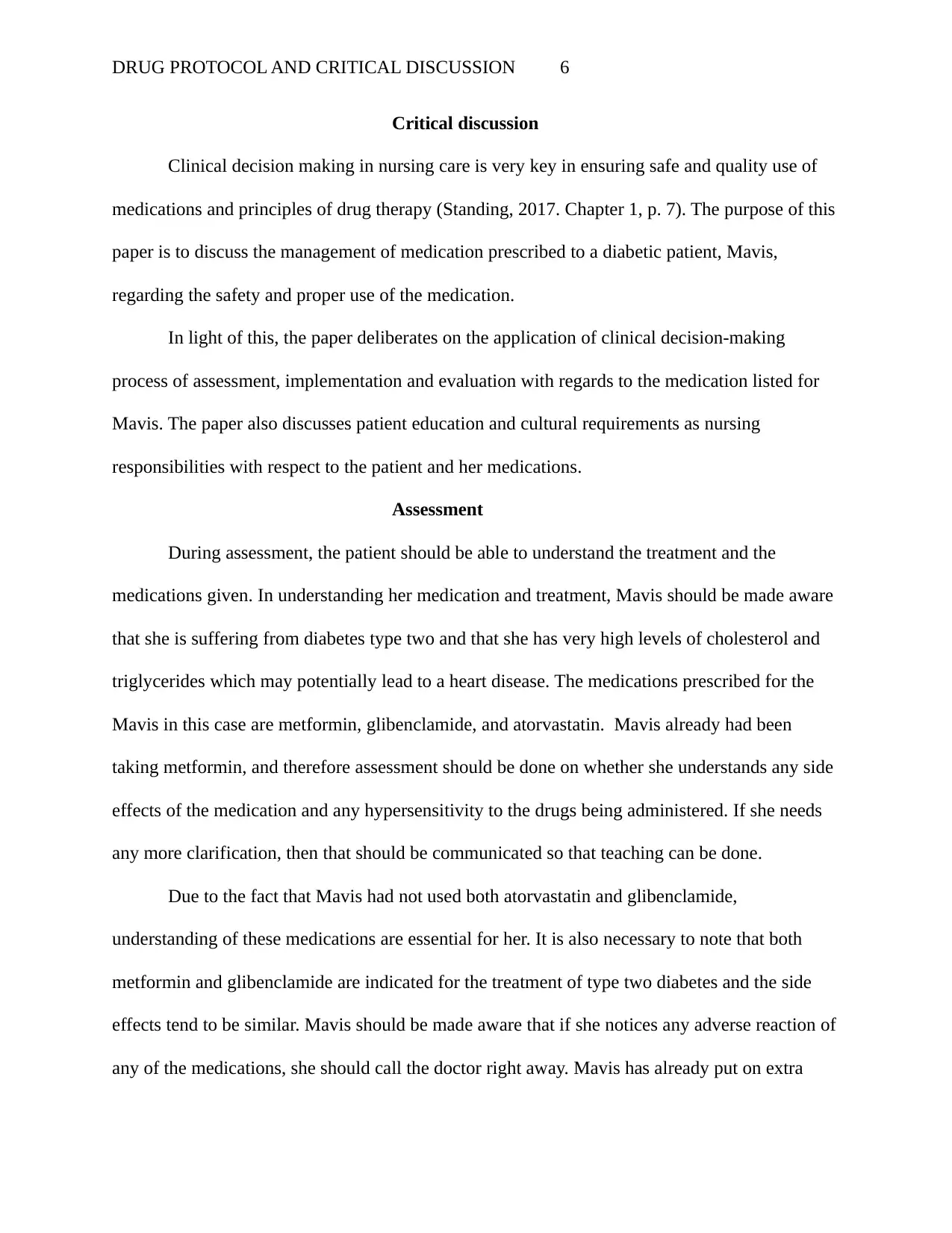
DRUG PROTOCOL AND CRITICAL DISCUSSION 6
Critical discussion
Clinical decision making in nursing care is very key in ensuring safe and quality use of
medications and principles of drug therapy (Standing, 2017. Chapter 1, p. 7). The purpose of this
paper is to discuss the management of medication prescribed to a diabetic patient, Mavis,
regarding the safety and proper use of the medication.
In light of this, the paper deliberates on the application of clinical decision-making
process of assessment, implementation and evaluation with regards to the medication listed for
Mavis. The paper also discusses patient education and cultural requirements as nursing
responsibilities with respect to the patient and her medications.
Assessment
During assessment, the patient should be able to understand the treatment and the
medications given. In understanding her medication and treatment, Mavis should be made aware
that she is suffering from diabetes type two and that she has very high levels of cholesterol and
triglycerides which may potentially lead to a heart disease. The medications prescribed for the
Mavis in this case are metformin, glibenclamide, and atorvastatin. Mavis already had been
taking metformin, and therefore assessment should be done on whether she understands any side
effects of the medication and any hypersensitivity to the drugs being administered. If she needs
any more clarification, then that should be communicated so that teaching can be done.
Due to the fact that Mavis had not used both atorvastatin and glibenclamide,
understanding of these medications are essential for her. It is also necessary to note that both
metformin and glibenclamide are indicated for the treatment of type two diabetes and the side
effects tend to be similar. Mavis should be made aware that if she notices any adverse reaction of
any of the medications, she should call the doctor right away. Mavis has already put on extra
Critical discussion
Clinical decision making in nursing care is very key in ensuring safe and quality use of
medications and principles of drug therapy (Standing, 2017. Chapter 1, p. 7). The purpose of this
paper is to discuss the management of medication prescribed to a diabetic patient, Mavis,
regarding the safety and proper use of the medication.
In light of this, the paper deliberates on the application of clinical decision-making
process of assessment, implementation and evaluation with regards to the medication listed for
Mavis. The paper also discusses patient education and cultural requirements as nursing
responsibilities with respect to the patient and her medications.
Assessment
During assessment, the patient should be able to understand the treatment and the
medications given. In understanding her medication and treatment, Mavis should be made aware
that she is suffering from diabetes type two and that she has very high levels of cholesterol and
triglycerides which may potentially lead to a heart disease. The medications prescribed for the
Mavis in this case are metformin, glibenclamide, and atorvastatin. Mavis already had been
taking metformin, and therefore assessment should be done on whether she understands any side
effects of the medication and any hypersensitivity to the drugs being administered. If she needs
any more clarification, then that should be communicated so that teaching can be done.
Due to the fact that Mavis had not used both atorvastatin and glibenclamide,
understanding of these medications are essential for her. It is also necessary to note that both
metformin and glibenclamide are indicated for the treatment of type two diabetes and the side
effects tend to be similar. Mavis should be made aware that if she notices any adverse reaction of
any of the medications, she should call the doctor right away. Mavis has already put on extra
⊘ This is a preview!⊘
Do you want full access?
Subscribe today to unlock all pages.

Trusted by 1+ million students worldwide
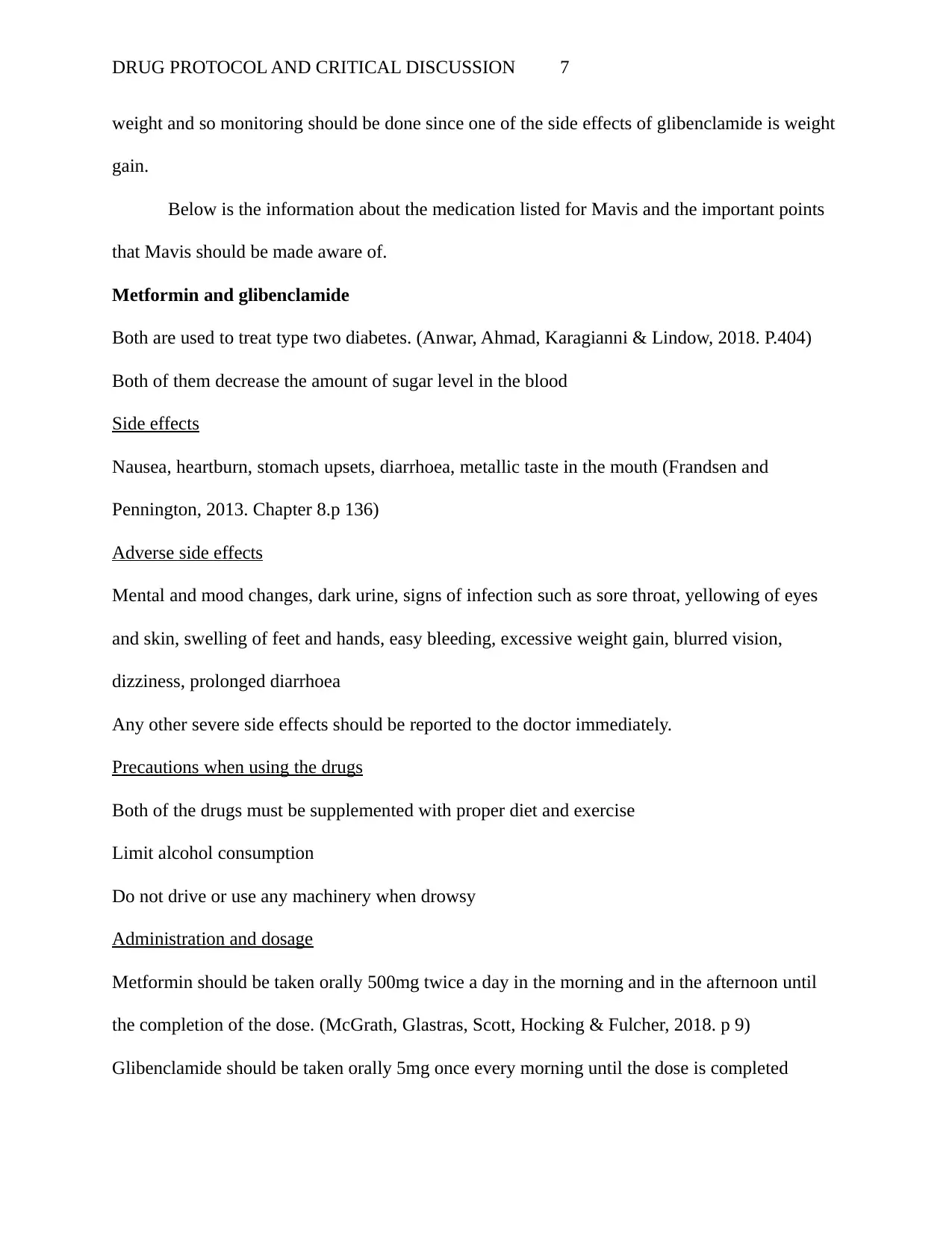
DRUG PROTOCOL AND CRITICAL DISCUSSION 7
weight and so monitoring should be done since one of the side effects of glibenclamide is weight
gain.
Below is the information about the medication listed for Mavis and the important points
that Mavis should be made aware of.
Metformin and glibenclamide
Both are used to treat type two diabetes. (Anwar, Ahmad, Karagianni & Lindow, 2018. P.404)
Both of them decrease the amount of sugar level in the blood
Side effects
Nausea, heartburn, stomach upsets, diarrhoea, metallic taste in the mouth (Frandsen and
Pennington, 2013. Chapter 8.p 136)
Adverse side effects
Mental and mood changes, dark urine, signs of infection such as sore throat, yellowing of eyes
and skin, swelling of feet and hands, easy bleeding, excessive weight gain, blurred vision,
dizziness, prolonged diarrhoea
Any other severe side effects should be reported to the doctor immediately.
Precautions when using the drugs
Both of the drugs must be supplemented with proper diet and exercise
Limit alcohol consumption
Do not drive or use any machinery when drowsy
Administration and dosage
Metformin should be taken orally 500mg twice a day in the morning and in the afternoon until
the completion of the dose. (McGrath, Glastras, Scott, Hocking & Fulcher, 2018. p 9)
Glibenclamide should be taken orally 5mg once every morning until the dose is completed
weight and so monitoring should be done since one of the side effects of glibenclamide is weight
gain.
Below is the information about the medication listed for Mavis and the important points
that Mavis should be made aware of.
Metformin and glibenclamide
Both are used to treat type two diabetes. (Anwar, Ahmad, Karagianni & Lindow, 2018. P.404)
Both of them decrease the amount of sugar level in the blood
Side effects
Nausea, heartburn, stomach upsets, diarrhoea, metallic taste in the mouth (Frandsen and
Pennington, 2013. Chapter 8.p 136)
Adverse side effects
Mental and mood changes, dark urine, signs of infection such as sore throat, yellowing of eyes
and skin, swelling of feet and hands, easy bleeding, excessive weight gain, blurred vision,
dizziness, prolonged diarrhoea
Any other severe side effects should be reported to the doctor immediately.
Precautions when using the drugs
Both of the drugs must be supplemented with proper diet and exercise
Limit alcohol consumption
Do not drive or use any machinery when drowsy
Administration and dosage
Metformin should be taken orally 500mg twice a day in the morning and in the afternoon until
the completion of the dose. (McGrath, Glastras, Scott, Hocking & Fulcher, 2018. p 9)
Glibenclamide should be taken orally 5mg once every morning until the dose is completed
Paraphrase This Document
Need a fresh take? Get an instant paraphrase of this document with our AI Paraphraser

DRUG PROTOCOL AND CRITICAL DISCUSSION 8
Atorvastatin
Medication is used for the treatment of high cholesterol levels (Ramrakha, 2013.chapter 5,
p.236)
Side effects
Diarrhea, heartburn, gas, joint
Adverse side effects
Confusion and memory problems, dry mouth, unexplained muscle pain or tenderness, fruity
breath, odour dark coloured urine, urinating less than normal or not urinating at all.
Precautions
Avoid taking grape juice
Supplement with proper diet and exercise
Administration and dosage
Take orally 40mg once every night until the completion of the dose
Implementation
In order to make sure that implementation of the assessment done is achieved, Mavis
should be made aware that diet and exercise is key to her treatment process (Ramrakha, 2013
chapter 5, p. S52) Therefore, dieticians will be able to talk to her on the importance of checking
her diet. A diet plan may also be appropriate for her and review done at least weekly.
There may also be need of formulating an exercise plan for her and inquire with any of
the family members to be assisting with exercises. Monitoring of the proper administration and
dosage of the medications is also necessary to ensure that Mavis has understood the dosage and
administration of the drugs (Avorn, 2018, p.690). A care plan needs to be written up so that all
the education done is implemented.
Atorvastatin
Medication is used for the treatment of high cholesterol levels (Ramrakha, 2013.chapter 5,
p.236)
Side effects
Diarrhea, heartburn, gas, joint
Adverse side effects
Confusion and memory problems, dry mouth, unexplained muscle pain or tenderness, fruity
breath, odour dark coloured urine, urinating less than normal or not urinating at all.
Precautions
Avoid taking grape juice
Supplement with proper diet and exercise
Administration and dosage
Take orally 40mg once every night until the completion of the dose
Implementation
In order to make sure that implementation of the assessment done is achieved, Mavis
should be made aware that diet and exercise is key to her treatment process (Ramrakha, 2013
chapter 5, p. S52) Therefore, dieticians will be able to talk to her on the importance of checking
her diet. A diet plan may also be appropriate for her and review done at least weekly.
There may also be need of formulating an exercise plan for her and inquire with any of
the family members to be assisting with exercises. Monitoring of the proper administration and
dosage of the medications is also necessary to ensure that Mavis has understood the dosage and
administration of the drugs (Avorn, 2018, p.690). A care plan needs to be written up so that all
the education done is implemented.
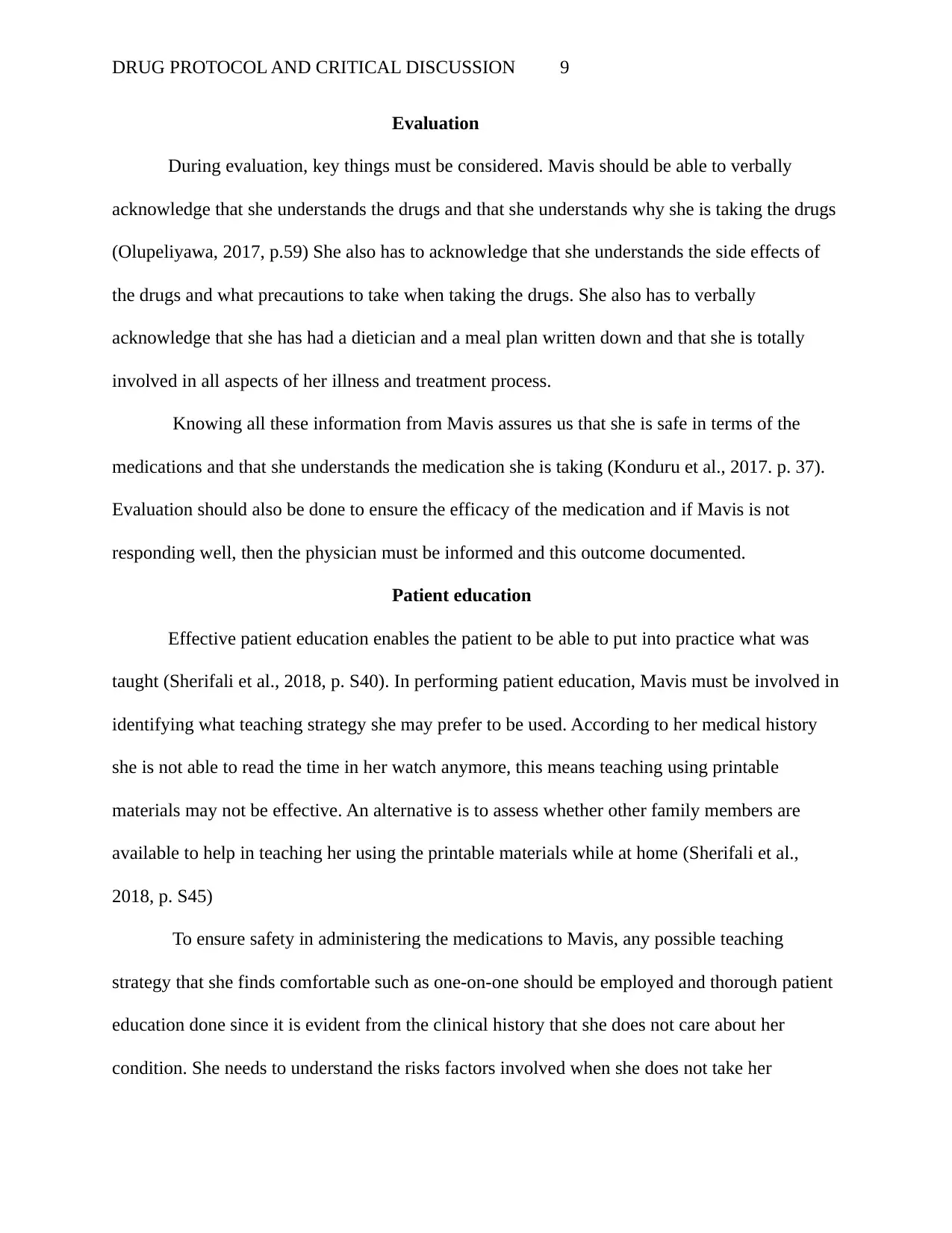
DRUG PROTOCOL AND CRITICAL DISCUSSION 9
Evaluation
During evaluation, key things must be considered. Mavis should be able to verbally
acknowledge that she understands the drugs and that she understands why she is taking the drugs
(Olupeliyawa, 2017, p.59) She also has to acknowledge that she understands the side effects of
the drugs and what precautions to take when taking the drugs. She also has to verbally
acknowledge that she has had a dietician and a meal plan written down and that she is totally
involved in all aspects of her illness and treatment process.
Knowing all these information from Mavis assures us that she is safe in terms of the
medications and that she understands the medication she is taking (Konduru et al., 2017. p. 37).
Evaluation should also be done to ensure the efficacy of the medication and if Mavis is not
responding well, then the physician must be informed and this outcome documented.
Patient education
Effective patient education enables the patient to be able to put into practice what was
taught (Sherifali et al., 2018, p. S40). In performing patient education, Mavis must be involved in
identifying what teaching strategy she may prefer to be used. According to her medical history
she is not able to read the time in her watch anymore, this means teaching using printable
materials may not be effective. An alternative is to assess whether other family members are
available to help in teaching her using the printable materials while at home (Sherifali et al.,
2018, p. S45)
To ensure safety in administering the medications to Mavis, any possible teaching
strategy that she finds comfortable such as one-on-one should be employed and thorough patient
education done since it is evident from the clinical history that she does not care about her
condition. She needs to understand the risks factors involved when she does not take her
Evaluation
During evaluation, key things must be considered. Mavis should be able to verbally
acknowledge that she understands the drugs and that she understands why she is taking the drugs
(Olupeliyawa, 2017, p.59) She also has to acknowledge that she understands the side effects of
the drugs and what precautions to take when taking the drugs. She also has to verbally
acknowledge that she has had a dietician and a meal plan written down and that she is totally
involved in all aspects of her illness and treatment process.
Knowing all these information from Mavis assures us that she is safe in terms of the
medications and that she understands the medication she is taking (Konduru et al., 2017. p. 37).
Evaluation should also be done to ensure the efficacy of the medication and if Mavis is not
responding well, then the physician must be informed and this outcome documented.
Patient education
Effective patient education enables the patient to be able to put into practice what was
taught (Sherifali et al., 2018, p. S40). In performing patient education, Mavis must be involved in
identifying what teaching strategy she may prefer to be used. According to her medical history
she is not able to read the time in her watch anymore, this means teaching using printable
materials may not be effective. An alternative is to assess whether other family members are
available to help in teaching her using the printable materials while at home (Sherifali et al.,
2018, p. S45)
To ensure safety in administering the medications to Mavis, any possible teaching
strategy that she finds comfortable such as one-on-one should be employed and thorough patient
education done since it is evident from the clinical history that she does not care about her
condition. She needs to understand the risks factors involved when she does not take her
⊘ This is a preview!⊘
Do you want full access?
Subscribe today to unlock all pages.

Trusted by 1+ million students worldwide
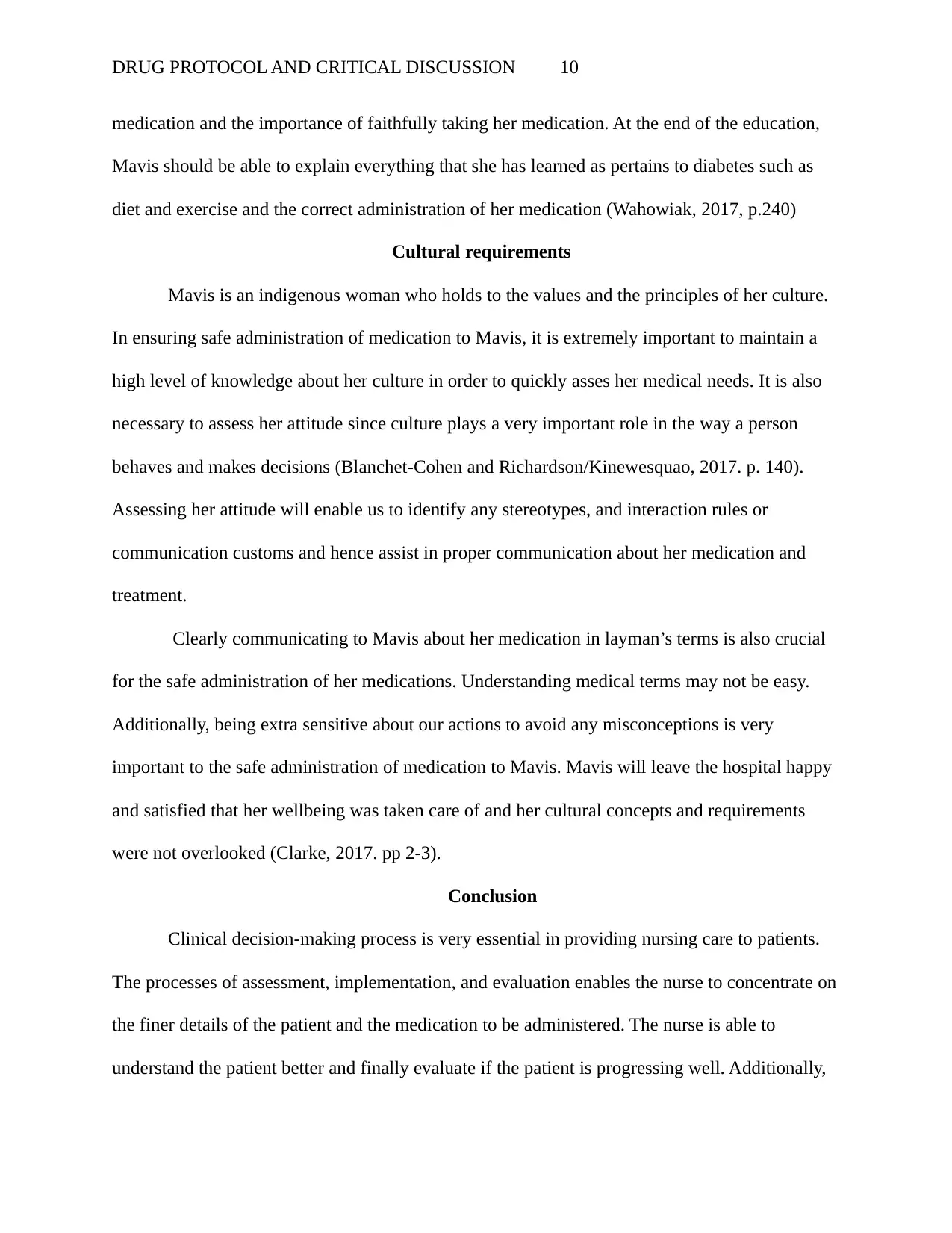
DRUG PROTOCOL AND CRITICAL DISCUSSION 10
medication and the importance of faithfully taking her medication. At the end of the education,
Mavis should be able to explain everything that she has learned as pertains to diabetes such as
diet and exercise and the correct administration of her medication (Wahowiak, 2017, p.240)
Cultural requirements
Mavis is an indigenous woman who holds to the values and the principles of her culture.
In ensuring safe administration of medication to Mavis, it is extremely important to maintain a
high level of knowledge about her culture in order to quickly asses her medical needs. It is also
necessary to assess her attitude since culture plays a very important role in the way a person
behaves and makes decisions (Blanchet-Cohen and Richardson/Kinewesquao, 2017. p. 140).
Assessing her attitude will enable us to identify any stereotypes, and interaction rules or
communication customs and hence assist in proper communication about her medication and
treatment.
Clearly communicating to Mavis about her medication in layman’s terms is also crucial
for the safe administration of her medications. Understanding medical terms may not be easy.
Additionally, being extra sensitive about our actions to avoid any misconceptions is very
important to the safe administration of medication to Mavis. Mavis will leave the hospital happy
and satisfied that her wellbeing was taken care of and her cultural concepts and requirements
were not overlooked (Clarke, 2017. pp 2-3).
Conclusion
Clinical decision-making process is very essential in providing nursing care to patients.
The processes of assessment, implementation, and evaluation enables the nurse to concentrate on
the finer details of the patient and the medication to be administered. The nurse is able to
understand the patient better and finally evaluate if the patient is progressing well. Additionally,
medication and the importance of faithfully taking her medication. At the end of the education,
Mavis should be able to explain everything that she has learned as pertains to diabetes such as
diet and exercise and the correct administration of her medication (Wahowiak, 2017, p.240)
Cultural requirements
Mavis is an indigenous woman who holds to the values and the principles of her culture.
In ensuring safe administration of medication to Mavis, it is extremely important to maintain a
high level of knowledge about her culture in order to quickly asses her medical needs. It is also
necessary to assess her attitude since culture plays a very important role in the way a person
behaves and makes decisions (Blanchet-Cohen and Richardson/Kinewesquao, 2017. p. 140).
Assessing her attitude will enable us to identify any stereotypes, and interaction rules or
communication customs and hence assist in proper communication about her medication and
treatment.
Clearly communicating to Mavis about her medication in layman’s terms is also crucial
for the safe administration of her medications. Understanding medical terms may not be easy.
Additionally, being extra sensitive about our actions to avoid any misconceptions is very
important to the safe administration of medication to Mavis. Mavis will leave the hospital happy
and satisfied that her wellbeing was taken care of and her cultural concepts and requirements
were not overlooked (Clarke, 2017. pp 2-3).
Conclusion
Clinical decision-making process is very essential in providing nursing care to patients.
The processes of assessment, implementation, and evaluation enables the nurse to concentrate on
the finer details of the patient and the medication to be administered. The nurse is able to
understand the patient better and finally evaluate if the patient is progressing well. Additionally,
Paraphrase This Document
Need a fresh take? Get an instant paraphrase of this document with our AI Paraphraser

DRUG PROTOCOL AND CRITICAL DISCUSSION 11
effective patient education and understanding of the cultural affiliations of a patient ensures safe
administration of medication to the patients (Sherifali et al., 2018. Pp S39-40) and ensures that
the patient is comfortable to interact with the nurses and talk about her needs freely.
effective patient education and understanding of the cultural affiliations of a patient ensures safe
administration of medication to the patients (Sherifali et al., 2018. Pp S39-40) and ensures that
the patient is comfortable to interact with the nurses and talk about her needs freely.

DRUG PROTOCOL AND CRITICAL DISCUSSION 12
References
Anwar, A., Ahmad, K., Karagianni, E., & Lindow, S. (2018). Medical Management of
Gestational Diabetes. Open Journal Of Obstetrics And Gynecology, 08(04), 400-407. doi:
10.4236/ojog.2018.84045
Avorn, J. (2018). The Psychology of Clinical Decision Making — Implications for Medication
Use. New England Journal Of Medicine, 378(8), 689-691. doi: 10.1056/nejmp1714987
Blanchet-Cohen, N., & Richardson/Kinewesquao, C. (2017). Foreword: fostering cultural safety
across contexts. Alternative: An International Journal Of Indigenous Peoples, 13(3), 138-
141. doi: 10.1177/1177180117714139
Clarke, S. (2017). Cultural Congruent Care: A Reflection on Patient Outcome. Journal Of
Healthcare Communications, 02(04), p.1-3. doi: 10.4172/2472-1654.100092
Frandsen, G., & Pennington, S. (2013). Abrams' clinical drug therapy. Lippincott Williams &
Wilkins.
Freinkel, N. (2017). Professional Practice Committee:Standards of Medical Care in Diabetes—
2018. Diabetes Care, 41(Supplement 1), S51-S53. doi: 10.2337/dc18-sppc01
Konduru, S., Ranjan, A., K, K., Muddada, S., Shaik, S., & Vakkapatla, L. (2017). Assessment of
Diabetes Related Knowledge, Attitude and Practice among Diabetics and Non-diabetics
using Self Prepared Questionnaire for Awareness of Health Promotion. Indian Journal Of
Pharmacy Practice, 10(1), 32-38. doi: 10.5530/ijopp.10.1.8
References
Anwar, A., Ahmad, K., Karagianni, E., & Lindow, S. (2018). Medical Management of
Gestational Diabetes. Open Journal Of Obstetrics And Gynecology, 08(04), 400-407. doi:
10.4236/ojog.2018.84045
Avorn, J. (2018). The Psychology of Clinical Decision Making — Implications for Medication
Use. New England Journal Of Medicine, 378(8), 689-691. doi: 10.1056/nejmp1714987
Blanchet-Cohen, N., & Richardson/Kinewesquao, C. (2017). Foreword: fostering cultural safety
across contexts. Alternative: An International Journal Of Indigenous Peoples, 13(3), 138-
141. doi: 10.1177/1177180117714139
Clarke, S. (2017). Cultural Congruent Care: A Reflection on Patient Outcome. Journal Of
Healthcare Communications, 02(04), p.1-3. doi: 10.4172/2472-1654.100092
Frandsen, G., & Pennington, S. (2013). Abrams' clinical drug therapy. Lippincott Williams &
Wilkins.
Freinkel, N. (2017). Professional Practice Committee:Standards of Medical Care in Diabetes—
2018. Diabetes Care, 41(Supplement 1), S51-S53. doi: 10.2337/dc18-sppc01
Konduru, S., Ranjan, A., K, K., Muddada, S., Shaik, S., & Vakkapatla, L. (2017). Assessment of
Diabetes Related Knowledge, Attitude and Practice among Diabetics and Non-diabetics
using Self Prepared Questionnaire for Awareness of Health Promotion. Indian Journal Of
Pharmacy Practice, 10(1), 32-38. doi: 10.5530/ijopp.10.1.8
⊘ This is a preview!⊘
Do you want full access?
Subscribe today to unlock all pages.

Trusted by 1+ million students worldwide
1 out of 13
Your All-in-One AI-Powered Toolkit for Academic Success.
+13062052269
info@desklib.com
Available 24*7 on WhatsApp / Email
![[object Object]](/_next/static/media/star-bottom.7253800d.svg)
Unlock your academic potential
Copyright © 2020–2025 A2Z Services. All Rights Reserved. Developed and managed by ZUCOL.


